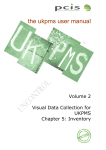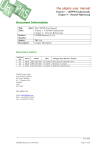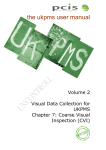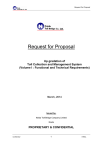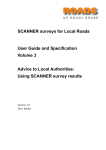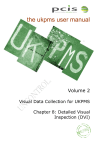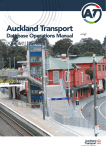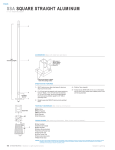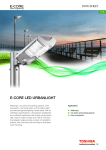Download the ukpms user manual
Transcript
the ukpms user manual Volume 2 Visual Data Collection for UKPMS Chapter 1: Overview of Visual Data Collection the ukpms user manual Volume 2: Visual Data Collection for UKPMS Chapter1: Overview of Visual Data Collection Document Information Title (Sub Title) Product Number Author Description The UKPMS User Manual Volume 2: Visual Data Collection for UKPMS Chapter 1. Overview of Visual Data Collection UKPMS Manual July 2009 James Wallis UKPMS Visual Survey Manual Introductory and Overview Chapter Document History Version No Status Author Date 01 02 03 04 Draft Draft Final Revised JW JW JW JW March 05 20 June 05 July 2005 Feb 2007 05 06 07 08 Revised Review Revised Final JW JW KAG ME July 2009 Sept 2009 Oct 2009 30 Oct 2009 Changes from Previous Version First release for internal review All USG comments incorporated, issued for proof reading Final for release Changes in line with new Inspector Accreditation and recommendations from UKPMS Visual Survey subGroup Incorporating changes since 2007 Issued for external review Revised following review Final for release PCIS Support Contractor TRL Crowthorne House Nine Mile Ride Wokingham Berkshire RG40 3GA www.pcis.org.uk Email: [email protected] Phone: +44 (0)1344 770480 Fax: +44 (0)1344 770356 UKPMS Manual_02_01v08.doc October 2009 Page 1 of Chapter 1 the ukpms user manual Volume 2: Visual Data Collection for UKPMS Chapter1: Overview of Visual Data Collection Contents 1 2 3 4 5 6 7 8 9 10 11 12 13 14 15 Who should read this manual?......................................................................................... 3 What is UKPMS? ............................................................................................................... 3 What are the UKPMS Visual Surveys? ........................................................................... 3 What are the UKPMS Visual Surveys used for? ........................................................... 4 Who should carry out UKPMS Visual Surveys? ........................................................... 5 Health and Safety ............................................................................................................... 5 Visual Survey Details......................................................................................................... 6 Network and Location Referencing..............................................................................11 Cross Section Positions ..................................................................................................14 "Not Assessed" and "Not Defective" Features ..........................................................15 Relationship of CVI and DVI Defects .........................................................................16 Surveying Procedures ......................................................................................................21 Frequently asked questions ............................................................................................22 Abbreviations ...................................................................................................................33 Acknowledgements .........................................................................................................34 UKPMS Manual_02_01v08.doc October 2009 Page 2 of Chapter 1 the ukpms user manual Volume 2: Visual Data Collection for UKPMS Chapter1: Overview of Visual Data Collection 1 Who should read this manual? This manual is intended to provide surveyors and those responsible for auditing visual surveys with the necessary information to carry out all UKPMS accredited Visual Inspections accurately and consistently. It will also be of interest and relevance to managers, engineers and auditors who are responsible for arranging for surveys to be carried out and who have to interpret or assess the output produced from those surveys. 2 What is UKPMS? UKPMS, the United Kingdom Pavement Management System, is a standard for computer systems that support the management of programmed maintenance of hard paved areas within the highway, and the monitoring of condition and need for funding on local authority road networks within the UK. There is no single UKPMS, but a range of commercial highway management systems have been tested and accredited as meeting the UKPMS standard. As well as software, the UKPMS standard also covers the associated survey techniques, and rules and parameters that allow the systems to be operated in a consistent, standard way. 3 What are the UKPMS Visual Surveys? There are three types of UKPMS visual survey. The Coarse Visual Inspection survey (CVI) is intended to be a simple, rapid survey, usually carried out from a slow-moving vehicle, that enables a large part of a highways authority’s road network to be assessed each year. The CVI protocol includes both carriageways and footways. The Detailed Visual Inspection survey (DVI) is a more comprehensive survey, with defects identified by a larger number of more detailed classifications. The DVI is a walked survey that provides more detailed information and is typically targeted at lengths already identified as defective and potentially in need of treatment either from other surveys or other sources of information. The DVI protocol includes both carriageways and footways. The Footway Network Survey (FNS) is intended to be a simple, rapid survey of the footway network. It is a walked survey that enables a large part of a highways authority’s footway network to be assessed each year. It is intended to be used for identifying lengths of network which are potentially in need of more detailed investigation or of treatment. UKPMS Manual_02_01v08.doc October 2009 Page 3 of Chapter 1 the ukpms user manual Volume 2: Visual Data Collection for UKPMS Chapter1: Overview of Visual Data Collection For the purposes of this manual, the terms “survey” and “inspection” are used interchangeably, to denote the type of condition assessment technique, of which CVI, DVI and FNS are examples, where condition and the need for planned maintenance schemes are assessed from a visual examination of the paved surfaces of the road. It is envisaged that more detailed engineering investigations and surveys would be carried out before planned maintenance schemes; such surveys are not covered in this manual. UKPMS Visual Surveys only include a minimal amount of inventory, collected to support processing and treatment selection requirements, although the surveys may be combined with Inventory data (i.e. locations, dimensions and construction of paved items) to produce more accurate results when processed in a UKPMS System. Refer to Chapter 5 Inventory in Volume 2 of this UKPMS User Manual. Some users may find it cost-effective to carry out Inventory data collection at the same time as a DVI. 4 What are the UKPMS Visual Surveys used for? In many authorities UKPMS visual surveys have multiple uses in pavement asset management, typically for monitoring network condition and performance, identifying and prioritising schemes and works programmes, and determining budgetary needs and financial allocations. Condition surveys are also used to provide financial information for asset management, such as depreciated replacement cost. Visual surveys complement machine surveys such as the Deflectograph, SCRIM and SCANNER on classified roads and are the main source of condition information on the rest of the network. Information from visual surveys can be used for internal performance monitoring and benchmarking between authorities. For example: To produce internal performance indicators (sometimes referred to as Key Performance Indicators, KPI). To inform decisions about how, when and where to carry out maintenance schemes within an authority, and to support the internal audit of such decisions. To support an authority’s Asset Management Plan, including; Determining a required level of budget and investment over time to maintain or to achieve a required condition or level of service for a road network. UKPMS Manual_02_01v08.doc October 2009 Page 4 of Chapter 1 the ukpms user manual Volume 2: Visual Data Collection for UKPMS Chapter1: Overview of Visual Data Collection Assessing the future implications of current levels of funding. Determining the depreciated value of the paved assets in the network. 5 Who should carry out UKPMS Visual Surveys? UKPMS surveys are designed to be carried out by staff trained in the relevant survey techniques, and who are able to record defects accurately and consistently, in accordance with the definitions and procedures described in this manual. UKPMS surveyors are not expected to make decisions about the cause of defects, required treatments or to make other engineering judgements. Objectivity and consistency are paramount considerations in carrying out visual surveys. UKPMS accredited surveys may only be carried out by UKPMS accredited inspectors. An inspector accreditation system, endorsed by the UK Roads Board, has been in place for a number of years with the support of local highway authorities and commercial contractors. Further information is provided in Chapter 2 Inspector Accreditation in Volume 2 of this UKPMS User Manual. Due to the importance that local highway authorities place on consistent, reliable condition data collected for planning maintenance, for asset management and for asset valuation it is recommended that all visual surveys are undertaken by accredited inspectors. To ensure that surveys are consistent it is recommended that any staff who manage surveyors or audit the results from surveys should be trained and accredited to the same level as the inspectors. The results from visual inspection surveys are normally recorded using hand held data capture devices. The software for recording the results should also be accredited, to ensure consistency and reliability. Further information is provided in Chapter 3 DCD Software Accreditation in Volume 2 of this UKPMS User Manual. 6 Health and Safety The following information is only general advice, the surveyor should be made aware of the contractor’s or highway authority’s own health and safety policy before they undertake any surveys, including risk assessments, and this must take precedence over the general advice within this chapter. Surveyors should report any safety related defect, even where there may be no specific requirement to do so in the survey being undertaken. The surveyor must be made aware of the highway authority’s policy on safety related defects and ensure they know who to contact in case of emergency. UKPMS Manual_02_01v08.doc October 2009 Page 5 of Chapter 1 the ukpms user manual Volume 2: Visual Data Collection for UKPMS Chapter1: Overview of Visual Data Collection It is important that surveyors remain alert to the dangers of moving vehicles. To ensure that surveyors can always be seen, high visibility jackets conforming to BS EN 471:2003 should be worn at all times, when outside a survey vehicle. Where possible, surveys on foot should be carried out from the footway or verge. When measurements are being made on the carriageway (e.g. rut depth) by one surveyor, the other surveyor should act as a lookout to warn of oncoming traffic. On dual carriageways and other busy roads with fast moving traffic, traffic management will normally be required to ensure a safe survey. This should be in accordance with Chapter 8 of the Department for Transport’s Traffic Signs Manual. For CVI surveys, the survey vehicle should be equipped with high intensity roofmounted flashing beacons. As the vehicle will be operating at slow speeds, it is recommended that the rear of the vehicle should be fitted with a blue arrow sign to diagram No. 610 of the Traffic Signs Regulations and General Directions 2002, together with a sign explaining the nature of the work (e.g. "CAUTION SURVEYING IN PROGRESS - SLOW MOVING VEHICLE"). It is preferable to use a vehicle with a conspicuous colour such as bright yellow or orange. In planning the survey any traffic sensitive lengths that are best-surveyed at off-peak times should be identified. A minimum of two personnel are required for a driven survey, a driver and a surveyor. 7 Visual Survey Details 7.1 Wheel Track Rutting Wheel Track rutting is defined as a longitudinal depression in the wheel tracks relative to the surrounding area. Note that for UKPMS surveys, no distinction is made between "plastic" rutting, where rutting results from "pushing" of bituminous material in the upper layer(s) of the pavement and “structural” rutting, where rutting results from structural deformation in lower layers of the pavement. Figure 1 “Structural” Wheel Track Rutting UKPMS Manual_02_01v08.doc October 2009 Page 6 of Chapter 1 the ukpms user manual Volume 2: Visual Data Collection for UKPMS Chapter1: Overview of Visual Data Collection Figure 2 “Plastic” Wheel Track Rutting Wheel track rutting can be surveyed manually. For CVI surveys a simple visual assessment can be undertaken. For DVI surveys a straight edge and calibrated wedge or depth measure can be used. However, the preferred option, for both types of survey, is to undertake a machine-based assessment. This is recommended both on grounds of accuracy, and for DVI surveys, safety since it removes the need to walk onto the carriageway. Two special survey types of Machine Collected Rutting for DVI (DRUT) and Machine Collected Rutting for CVI (CRUT) have been defined to support the loading and processing of such with visual surveys. Further information on CRUT and DRUT is provided in Volume 3 “Machine Data Collection for UKPMS” of this UKPMS User Manual.. More recently, with the development of machine based survey methods, such as SCANNER, rut depth is measured automatically as part of the survey. Further information on SCANNER measurements of rut depth is given in Volume 3 “Advice to local authorities – Using SCANNER survey results” of the SCANNER User Guide and Specification. Machine rut surveys use the Full Cross Sectional Position (XSP) referencing convention, separately for each lane. This will still allow Minimal XSP CVI surveys to be processed with Machine Rut data, although it will require that the DVI survey be carried out using the Full XSP convention. Further information on the use of Cross Sectional Position is provided in Chapter 6 Cross Sectional Position (XSP) of this UKPMS User Manual. 7.2 Features "Features" within UKPMS are the main paved items that are subject to survey, and for which condition indices and treatment proposals are produced. The Features within UKPMS are: Carriageway Footway and Footpath Cycleway and Cyclepath Paved Verge (Grass verges and other unmade areas are not covered by UKPMS) Kerb Longitudinal Joint in Concrete Transverse Joint in Concrete UKPMS Manual_02_01v08.doc October 2009 Page 7 of Chapter 1 the ukpms user manual Volume 2: Visual Data Collection for UKPMS Chapter1: Overview of Visual Data Collection 7.3 Survey Direction Sections may be surveyed in either a ‘forward direction’ or a ‘reverse direction’. The terms ‘forward’ and ‘reverse’ are used with respect to the ‘reference direction’ which is defined by the start and end nodes or the section description. On oneway streets and for dual carriageways, the reference direction of the section is the direction of traffic flow. Table 1 (below) is an example of a road section reference. The Description contains the “From” and “To” location. This is referred to as either the “Forward” or the “Normal” direction”. Section Label A/123456/00 Description James Street From Street A to Street B Length 300m Table 1 Section Reference Upon loading to the UKPMS system, reverse direction surveys will be reversed to match the normal direction recorded against the section. UKPMS includes a facility that allows a user to ensure that all surveys are always carried out in the same direction (i.e. forward or reverse), by recording a "normal surveying direction" against the section. It is recommended that in all but exceptional circumstances the normal surveying direction should be set to be the same as the referenced direction of the section. If a section is labelled as ‘reverse’ then the UKPMS system will alter the data automatically, i.e. the end chainage will become the start chainage (0) and the XSP’s will change from L to R and R to L. 7.4 Pavement Type, Surface Type and Construction Type Pavement Type - Bituminous Surface, Concrete Construction Surface Type Bituminous Construction Type Concrete Figure 3 Pavement Type, Surface Type and Construction Type The UKPMS approach for defects and processing is founded on three related concepts relating to the material from which a pavement under consideration is constructed. UKPMS Manual_02_01v08.doc October 2009 Page 8 of Chapter 1 the ukpms user manual Volume 2: Visual Data Collection for UKPMS Chapter1: Overview of Visual Data Collection The Surface Type is the material from which the visible element of the pavement is constituted. It is this surface element that is of concern when undertaking a visual survey. The Construction Type of a paved feature is the structural element of a pavement. The Pavement Type combines the surface and construction elements of the pavement and has the most important logical role within UKPMS processing. Each time a defect is recorded, the defect code will determine the Pavement Type, which is used to select the rules that are applied during UKPMS processing. This Pavement Type is based upon both the Surface Type implied by the survey data, but also any available information about construction held in the inventory, if this exists (In practice, observations always have a Pavement Type, even if, in the absence of a paved surface inventory, this is a "default", such as "Bituminous Surface Unknown Construction). Figure 3 shows this, by way of an example, for the Bituminous Surface, Covered Concrete Pavement Type. Table 2 shows all possible Pavement Types, and their related Surface and Construction Types for the Features covered by UKPMS visual surveys. In many cases the Surface, Construction and Pavement Types of a feature may be the same. Feature Carriageway Surface Type Bituminous Construction Type Bituminous Concrete Leanmix Unknown Block Paved Concrete Cycle Track Footway UKPMS Manual_02_01v08.doc Unknown Bituminous Block Paved Concrete Flagged Bituminous Block Paved Continuously Reinforced Concrete Reinforced Jointed Concrete Unknown Unreinforced Jointed Concrete Unknown Bituminous Block Paved Concrete Flagged Bituminous Pavement Type Bituminous Covered Concrete Bituminous Surface, Leanmix Construction Bituminous Surface, Unknown Construction Block Paved Continuously Reinforced Concrete Reinforced Jointed Concrete Concrete Surface, Unknown Construction Unreinforced Jointed Concrete Unknown Bituminous Block Paved Concrete Flagged Bituminous October 2009 Page 9 of Chapter 1 the ukpms user manual Volume 2: Visual Data Collection for UKPMS Chapter1: Overview of Visual Data Collection Feature Kerb Verge Surface Type Block Paved Concrete Flagged Unknown Kerb Bituminous Block Paved Concrete Flagged Construction Type Block Paved Concrete Flagged Unknown Kerb Bituminous Block Paved Concrete Flagged Pavement Type Block Paved Concrete Flagged Unknown Kerb Bituminous Block Paved Concrete Flagged Table 2 Surface, Construction and Pavement Types The Surface Types are as follows: Bituminous Carriageways Carriageways with a bituminous depth greater than 20mm at the surface, including hot rolled asphalt, stone mastic asphalt, dense bitumen macadam and other bituminous materials, including those with a surface dressing, proprietary thin surface, or with anti-skid surfacing applied. This includes flexible composite carriageways (“covered concrete”) with a lean-mix concrete sub-base. Concrete Carriageways All carriageways with a concrete surface, including continuously reinforced concrete (which will have only occasional joints), and concrete constructed in bays of reinforced or unreinforced concrete. Concrete carriageways that have a surface dressing or thin bituminous layer on top of them, less than 20mm thick, are also included. Block Paved Carriageways All types of carriageways constructed from small element blocks (including concrete, cobbles, granite setts, brick and, exceptionally, wooden blocks). Unknown Surface Carriageways This category is only used for machine surveys. Kerbs All kerb types, including concrete, stone and extruded asphalt. UKPMS Manual_02_01v08.doc October 2009 Page 10 of Chapter 1 the ukpms user manual Volume 2: Visual Data Collection for UKPMS Chapter1: Overview of Visual Data Collection Bituminous Footways, Cycleways and Paved Verges This category includes surface dressed or slurry-sealed features. Block Paved Footways, Cycleways and Paved Verges Concrete blocks, brick pavers, granite setts and other small element paving. Flagged Footways, Cycleways and Paved Verges Concrete and stone paving flags, including smaller, square modular concrete flags. Concrete Footways, Cycleways and Paved Verges Concrete surfaced, with or without joints. Unknown footways The FNS uses an "unknown" pavement type in order to make the survey independent of surface type, although if an inventory exists this will be used when the surveys are processed within UKPMS. 8 Network and Location Referencing In a UKPMS accredited system, a road network comprises a spatially located and uniquely-labelled set of sections of highway, which act as the key for referencing other related data (including inventory and condition). UKPMS network referencing is not prescriptive, the intention being that an existing network referencing system such as those previously used for CHART or MARCH surveys can be re-used, or that the National Street Gazetteer can form the basis of a section-based network. Minimising the number of networks used within an authority helps promote exchange and integration of road related data. At its simplest UKPMS network referencing requires that the road network is referenced to a list of unique sections, with some means of deriving a direction (even if only in the description), as described in section 7.3 “Survey Direction” of this chapter. Additionally, UKPMS provides the opportunity to introduce nodes, which unambiguously define direction, and connectivity between sections, and optionally, shape points, determined by the user. On those parts of the network where machine surveys, such as SCANNER, are carried out nodes must be used to identify the start and end points of the sections from which survey direction can be inferred by the UKPMS system. Further information is provided in Volume 1 Chapter 4 “Network Referencing” of this UKPMS User Manual. UKPMS network referencing is characterised as follows: UKPMS Manual_02_01v08.doc October 2009 Page 11 of Chapter 1 the ukpms user manual Volume 2: Visual Data Collection for UKPMS Chapter1: Overview of Visual Data Collection 1. The road network is divided into sections, each of which is identified uniquely by a section label. Sections have a designated start and end to enable specific defects to be located correctly to the left and right hand sides of the road within a section. Start chainage is always zero. As shown in Example 1 the sections should run contiguously. This will ensure that vehicle based surveys are carried out easily and minimises any errors in processing. This type of potential difficulty is illustrated in Example 2, where Section “1” is referenced in the opposite direction to Section “0” and Section “2”. 2. Location is referenced differently, depending on survey type. CVI and FNS defects are referenced by start and end chainage within section, and DVI defects by sub-section start and end chainages. In practice, the DCD software used for DVI surveys may allow defects to be recorded by actual start and end chainage, the allocation to sub-sections being handled automatically by the software. Note that whilst UKPMS makes use of chainage based referencing, this is not incompatible with the use of co-ordinate based systems such as GPS and GIS mapping software for data collection, reporting and interaction with the user, provided that the two systems can be co-related. 3. None of the following characteristics is permitted to change within a section (i.e. sections should be homogenous in terms of the following): Carriageway Construction Type. (In some exceptional cases a road section may contain different construction types. e.g.: Where a section on a concrete carriageway includes bituminous construction at bridge approaches, or within short housing estate cul-de-sacs.) Number of "Permanent" Lanes Road Classification Maintenance Hierarchy, unless this is held as an inventory attribute, in which case a “default” value will be held for the section. (Classification used for the allocation of priorities and for the definition and application of standards for highway maintenance, as recommended and detailed in the Code of Practice for Highway Maintenance Management – Well-maintained Highways, Roads Liaison Group, July 2005) Environment (i.e. whether it is "Urban" or "Rural") Speed Limit. (In principle, "Speed Limit" should not change within a section, as it is used for ranking schemes on the basis of condition. In practice, the current version of the UKPMS default rules and parameters does not use this facility, so that it may be possible to leave this out - you are advised to check with your UKPMS system supplier before making this decision.) For all surveys, each carriageway of a dual carriageway is considered separately, and referenced in the direction of traffic, as are roundabouts, which should always be surveyed in a clockwise direction. Example 3 and example 4 illustrate these points. UKPMS Manual_02_01v08.doc October 2009 Page 12 of Chapter 1 the ukpms user manual Volume 2: Visual Data Collection for UKPMS Chapter1: Overview of Visual Data Collection Network Referencing Examples (Minor Junction) (Major Junction) Section B Section A Section 0 Section 1 Section change at junction Section 2 Shows direction of referencing AND traffic Example 1 (Major Junction) (Minor Junction) Section A Section 0 Section B Section 1 Section change at junction Section 2 Shows direction of referencing NOT Traffic Direction Example 2 UKPMS Manual_02_01v08.doc October 2009 Page 13 of Chapter 1 the ukpms user manual Volume 2: Visual Data Collection for UKPMS Chapter1: Overview of Visual Data Collection Section 1 Section 4 Section 3 Section 2 Shows direction of referencing AND traffic Section 2 Example 3 Section B Section C Section 1 Section A Example 4 9 Cross Section Positions In addition to locating defects, inventory items, condition indices and indicative treatments by section and chainage, UKPMS provides a convention to locate items across the carriageway, using Cross Section Positions (XSP’s). There are two alternative levels of detail for defining the transverse location of a defect: Minimal (Simple) Cross Section Positions Full (Detailed) Cross Section Positions The level of detail to be used is predetermined before surveying each section, separately for the carriageway and for the off-carriageway features. Both the minimal and full options are provided to permit the user flexibility in application, according to the available resources, the requirements of a particular road hierarchy and survey type. UKPMS Manual_02_01v08.doc October 2009 Page 14 of Chapter 1 the ukpms user manual Volume 2: Visual Data Collection for UKPMS Chapter1: Overview of Visual Data Collection For example, the minimal method, which allocates information to the carriageway or to the "left" or "right”, would be sufficient for a little used street, where treatment of individual lanes is unlikely. The full method must be used where lanespecific machine surveys are carried out, and would be appropriate where treatment of an individual lane is a possibility. (Note that there are proposals to rationalise Cross Section Position referencing within UKPMS and to remove the distinction between full and minimal codes) For the minimal method, generally for CVI and FNS surveys, the transverse location of a defect will be defined broadly by features: Carriageway Left and Right Kerb Left and Right Footway/Cycletrack/Verge. In the case of Footways and Cycletracks that are not associated with a carriageway, they should be recorded on the Left. For the full method, the cross section position is a code representing a physical band across the highway, e.g. a traffic lane, a footway or a verge. For each section on the UKPMS network, the XSP method that should be used is recorded, separately for the Carriageway and for the Off-Carriageway Features. All surveys that are carried out on that section/feature must use the nominated XSP method, with the exception of CVI surveys, which can always be carried out using the minimal method. Further information on the use of Cross Sectional Position is provided in Chapter 6 Cross Sectional Position (XSP) of this UKPMS User Manual. 10 "Not Assessed" and "Not Defective" Features UKPMS provides for two "special" defects, for all surface types and features; "Not Assessed" and "Not Defective". "Not Assessed" means that although the recorded feature exists (for the chainage range and cross-section position recorded) it has not been inspected. This could either be intentionally, for example when a "Partial" survey is being carried out, or unintentionally, where for example road works or parked vehicles prevent the survey of a particular feature or section. "Not Defective" is only recorded for features and cross section positions where there are no "real" defects recorded on a section. "Not Defective" shows that although the feature has been inspected, it is free from reportable defects. Recording "Not Defective" means that areas that are in good condition are included in reports on the condition of road network, and can be used to "project" future conditions. Before carrying out a survey, you need to know whether that survey will be used for Condition Projection that is, to determine future condition to support future budgeting and to allocate priorities on the basis of the consequences of not UKPMS Manual_02_01v08.doc October 2009 Page 15 of Chapter 1 the ukpms user manual Volume 2: Visual Data Collection for UKPMS Chapter1: Overview of Visual Data Collection carrying out treatments. If so, recording of "Not Defective" for all features and cross section positions that exist would be desirable but it places considerable overheads on the UKPMS survey. Taking this into consideration it is recommended that “Not Defective” is not recorded as part of the UKPMS visual surveys, unless the user of that survey identifies a clear need for explicit recording of lengths that have no defects. For minimal XSP surveys of footways, cycletracks, paved verges and kerbs, “Not Defective” and/or “Not Assessed” should be recorded separately for each side (i.e. Left and Right) for which the feature exists. For the FNS, condition category one ("as new") indicates those parts of the section that have been surveyed but have no reportable defects and therefore there is no need for the special defects “not defective” and “not assessed”. Further information on the Footway Network Survey is provided in Chapter 9 Footway Network Survey of this UKPMS User Manual. 11 Relationship of CVI and DVI Defects The following tables show the relationships between CVI and DVI and between DVI and FNS defects. The results from DVI surveys can be converted into CVI and FNS surveys, therefore there needs to be a comparison between the defects which these tables show. UKPMS Manual_02_01v08.doc October 2009 Page 16 of Chapter 1 the ukpms user manual Volume 2: Visual Data Collection for UKPMS Chapter1: Overview of Visual Data Collection Feature All Surface Type All Carriageway Bituminous Block Paved UKPMS Manual_02_01v08.doc DVI Defect CVI Defect Not assessed Not defective WC major cracking WT major cracking Transverse/Reflection cracking – Severity 1 Transverse/Reflection cracking – Severity 2 WC minor fretting WC major chip loss WC major fatting WC minor chip loss WC minor fatting WC minor cracking WC major fretting Severe Local Settlement/Subsidence Moderate Local Settlement/Subsidence Left Recorded Edge deterioration Severity 1 Left Recorded Edge deterioration Severity 2 Right Recorded Edge deterioration Severity 1 Right Recorded Edge deterioration Severity 2 WT rutting WT Rutting Severe Block Deterioration Moderate Block Deterioration Damaged Blocks Misaligned Blocks Missing Filler Not assessed Not defective CVI Wearing Course CVI Transverse/Reflection Cracking CVI Surface deterioration Not Recorded for CVI CVI Wearing Course CVI Settlement/subsidence Not Recorded for CVI Left Recorded CVI Edge deterioration Right Recorded CVI Edge deterioration CVI Rutting CVI Rutting CVI Block Deterioration CVI Minor Deterioration Not Recorded Block October 2009 Page 17 of Chapter 1 the ukpms user manual Volume 2: Visual Data Collection for UKPMS Chapter1: Overview of Visual Data Collection Feature Surface Type Concrete DVI Defect CVI Defect Transverse Defective Seal CVI Transverse Defective Seal CVI Longitudinal Defective Seal CVI Transverse Joint Defectiveness Carriageway Longitudinal Defective Seal Kerb All Materials Major Transverse Joint Spalling Minor Transverse Joint Spalling Transverse Joint Faulting Transverse Joint Cracking Major Longitudinal Joint Spalling Minor Longitudinal Joint Spalling Longitudinal Joint Faulting Longitudinal Joint Cracking Minor Concrete Surface Deterioration Major Concrete Surface Deterioration Local Settlement Global Settlement Minor Single Cracking* Major Single Cracking* Multiple Cracking Bituminous Patching Inadequate Upstand Kerb Disintegration *Cracking defects have a "direction" parameter indicating whether they are longitudinal or transverse CVI Longitudinal Joint Defectiveness CVI Concrete Deterioration CVI Settlement Surface CVI Concrete Cracking CVI Bituminous Patching Inadequate Upstand Kerb Deterioration Table 3 Relationship between CVI and DVI Defects - Carriageway UKPMS Manual_02_01v08.doc October 2009 Page 18 of Chapter 1 the ukpms user manual Volume 2: Visual Data Collection for UKPMS Chapter1: Overview of Visual Data Collection Footway, Cycletrack and Paved Verge Feature Surface Type DVI Defect CVI Defect Bituminous Major Cracking Major Fretting Severe Local Settlement/Subsidence Moderate Local Settlement/Subsidence Spot Defects Longitudinal Trip Minor Cracking Minor Fretting Major Cracking Major Scaling/Fretting Severe Local Settlement/Subsidence Moderate Local Settlement/Subsidence Spot Defects Longitudinal Trip Minor Cracking Minor Scaling/Fretting Cracked and Depressed Flags Depressed Flags (not Cracked) Spot Defects Longitudinal Trip Cracked but Level Flags Cracked and Depressed Blocks Depressed or Missing Blocks Spot Defects Longitudinal Trip Damaged Blocks Missing Filler Major Bituminous Deterioration Concrete Flagged Block Paved Minor Bituminous Deterioration Major Concrete Deterioration Minor Concrete Deterioration Major Flagged Deterioration Minor Flagged Deterioration Major Block Deterioration Minor Block Deterioration Not Recorded Table 4 Relationship between CVI and DVI Defects – Footway UKPMS Manual_02_01v08.doc October 2009 Page 19 of Chapter 1 the ukpms user manual Volume 2: Visual Data Collection for UKPMS Chapter1: Overview of Visual Data Collection Footway, Cycletrack and Paved Verge Feature Surface Type DVI Defect FNS Defect Bituminous Major Cracking Major Fretting Severe Local Settlement/Subsidence Moderate Local Settlement/Subsidence Spot Defects Longitudinal Trip Minor Cracking Minor Fretting Major Cracking Major Scaling/Fretting Severe Local Settlement/Subsidence Moderate Local Settlement/Subsidence Spot Defects Longitudinal Trip Minor Cracking Minor Scaling/Fretting Cracked and Depressed Flags Depressed Flags (not Cracked) Spot Defects Longitudinal Trip Cracked but Level Flags Condition Category 4 (Structural Unsound) Concrete Flagged Block Paved Cracked and Depressed Blocks Depressed or Missing Blocks Spot Defects Longitudinal Trip Damaged Blocks Missing Filler Condition Category 3 (Functionally Impaired) Condition Category 4 (Structural Unsound) Condition Category 3 (Functionally Impaired) Condition Category 4 (Structural Unsound) Condition Category 3 (Functionally Impaired) Condition Category 4 (Structural Unsound) Condition Category 3 (Functionally Impaired) Table 5 Relationship between FNS and DVI Defects - Footway UKPMS Manual_02_01v08.doc October 2009 Page 20 of Chapter 1 the ukpms user manual Volume 2: Visual Data Collection for UKPMS Chapter1: Overview of Visual Data Collection 12 Surveying Procedures 12.1 Recording defects Defects must be recorded as stated within this manual or any future advice notes which may be issued from the PCIS Support Contractor. Each defect must be recorded accurately, for area and location. If multiple defects exist within the same area, each defect is to be recorded separately. The surveyor MUST NOT record what he/she thinks is the worst defect. The exception to this practice is for FNS surveys, where only one condition category can be recorded at any point along a footway. In cases where more than one condition category exists across the width of a footway, then the "worst" category is taken as representative, and the total extent of all conditions is applied to that category, where extent is being recorded. 12.2 Auditing At present there are no national rules for auditing visual survey data. It is important that you take ownership of this data and you consider having your own audit regime. Guidance on auditing is provided in Chapter 4 QA & Audit in Volume 2 of this UKPMS User Manual. . (www.pcis.org.uk) 12.3 Survey direction It is important the surveyor records the direction of survey in relation to the direction of the section referencing. If the survey is taking place in the opposite direction to the referencing then the survey MUST be marked as REVERSE. 12.4 Correct inventory If you have full inventory within your system, the system will look up the inventory table and process the data against this. Therefore it is important that when carrying out a visual survey you record the defects in the correct cross-sectional position. 12.5 Machine surveys When carrying out machine surveys, your system MUST be set up as having full cross-sectional positions on the carriageway. This means that if you plan to use minimal XSP CVI data on the same section you MUST have carriageway inventory information in the form of lane widths and lengths. UKPMS Manual_02_01v08.doc October 2009 Page 21 of Chapter 1 the ukpms user manual Volume 2: Visual Data Collection for UKPMS Chapter1: Overview of Visual Data Collection Frequently asked questions 13 Q1. Can I mix Full and Minimal XSP surveys on the same section? The Normal XSP Method is set separately for the carriageway and for the offcarriageway features, for each section on the network. All surveys on that section for the carriageway and for the other features should use the set method with one exception irrespective of the XSP method set. Minimal method CVI surveys can be carried out. For example, if the XSP method for the Carriageway is set as "Detailed" although DVI and Machine surveys must use the Detailed XSP method, you can still carry out Minimal method CVI surveys. (Note that if you wish to process Minimal CVI data and full XSP data from other surveys together, a full XSP inventory must have been collected. Proposals to simplify XSP referencing are likely to change these provisions in the future.) Q2. Can I carry out the surveys using paper forms? You cannot report surveys using paper forms if the survey is to be used for performance reporting. It may be viable to carry out very small-scale surveys using paper forms, for audit or training purposes. You should use electronic Data Capture Devices (DCD) together with appropriate accredited software for UKPMS visual surveys. Further information is provided in Chapter 3 DCD Software Accreditation in Volume 2 of this UKPMS User Manual. Details of accredited DCD software suppliers are given on the PCIS web site, www.pcis.org.uk. Q3. I have two separate footways on the same side of the section. Do I have to use Full XSP referencing to survey them? It is recommended that you use full XSP referencing in this situation for DVI surveys. But if you wish you can treat one of the footways as a paved verge (verges have the same defects, processing rules and associated standards as footways within UKPMS) and then you will be able to identify them separately. Note also that the footway classified as a paved verge will not be used in the calculation of BV187. For CVI and FNS surveys using the Minimal XSP method, they will be treated as if they were a single footway, which could lead to confusion or inaccuracy if their condition varies, or if they are of different construction. Q4. Should cracks that have been sealed be recorded? Sealed transverse and reflective cracks are not classed as defective within UKPMS. However, Wheel Track Cracking and Whole Carriageway Major Cracking on bituminous surfaced carriageways should still be recorded even if they have been sealed. Q5. How are edge defects that extend into trafficked areas of the carriageway recorded? Edge defects should only be recorded in locations where there is no kerb, channel blocks or other edge restraint. For cracking, fretting or deformation to be classified as edge deterioration, it must extend to the edge of the carriageway. If it extends beyond ½ UKPMS Manual_02_01v08.doc October 2009 Page 22 of Chapter 1 the ukpms user manual Volume 2: Visual Data Collection for UKPMS Chapter1: Overview of Visual Data Collection metre (500mm) from the edge of the carriageway it is also recorded as the appropriate defect, such as cracking, fretting or deformation. If cracking, fretting or deformation occurs within ½ metre of the edge of the carriageway, but does not extend to the edge of the carriageway, it is not recorded as edge deterioration, but only as the appropriate carriageway defect. In Figure 4, which shows four areas of major fretting, A and B are recorded as edge deterioration, but C and D are not because, although they are wholly or partly within the ½ metre edge strip, they do not extend to the edge. In this case, C and D plus that part of A that extends outside the ½ metre edge strip is also recorded as the appropriate carriageway fretting defect. In Figure 5, which shows four areas of major fretting, although they are wholly or partly within the ½ metre edge strip, the carriageway has an edge restraint and therefore edge deterioration should not be recorded but the defects should be recorded as the appropriate carriageway fretting defect. 500 Cway Edge No Kerb or Channel B C D A Figure 4 Edge Defects UKPMS Manual_02_01v08.doc October 2009 Page 23 of Chapter 1 the ukpms user manual Volume 2: Visual Data Collection for UKPMS Chapter1: Overview of Visual Data Collection 500 Kerb or Channel B C D A To be recorded as whole carriageway defect i.e. cracking, fretting etc. Figure 5 Edge Defects Q6. What are "Lane Length" defects? For both DVI and CVI surveys there are a number of defects where the lane length of the defect is required. For CVI surveys these defects (CVI Wheel Track Cracking) are recorded according to the number of lanes affected. For DVI surveys the “lane length affected” in linear metres is recorded for Wheel Track Cracking. For the defect to be present, there merely has to be some wheel track cracking in either or both of the wheel tracks. The total possible length within a sub-section will depend upon the cross-section position referencing method being used; using the Full XSP method the total possible lane length is the length of the sub section, whereas using the minimal XSP method, the total possible lane length is the length of the sub-section multiplied by the number of lanes present on the carriageway at that point. As an example, in Figure 6, the length between 0 to 40 on the left hand lane, and between 80 and 100 both lanes are affected by wheel track cracking. Using the minimal XSP method with 20m sub-sections, the maximum length that can be recorded for each subsection is 40m (i.e. sub-section length x no. of lanes). 20m of wheel track cracking is recorded for each of the first 2 sub-sections, and 40m is recorded for the final subsection. Remember that the Area of the cracking is also recorded as Whole Carriageway Major cracking in DVI surveys and Wearing Course Deterioration in CVI surveys. UKPMS Manual_02_01v08.doc October 2009 Page 24 of Chapter 1 the ukpms user manual Volume 2: Visual Data Collection for UKPMS Chapter1: Overview of Visual Data Collection 0m 20m 40m Major Cracking 80m 90m 100m Wheel Track Cracking Wheel paths Figure 6 Lane Length Defects Q7. Can video techniques be used for recording UKPMS visual survey data? You should not attempt to record defects from video surveys if the survey is to be used for performance reporting or benchmarking. A number of authorities have experimented with using digital video surveys to carry out CVI surveys, transcribing the data manually from the video after the survey, as if carrying out a “virtual” CVI. In principal, this approach is acceptable if: The same level of detail is achieved as from a driven survey (image resolution, no. of cameras and frequency of image capture being the determining factors), and The standard CVI procedure is adopted when transcribing the observations from the video. Indeed, provided that equivalent accuracy is achieved, this approach has the advantage of being more auditable and less dependent upon weather conditions. The video survey can also be used for other applications, such as inventory. It is recommended that if this approach is adopted, it is trialled on a small sample so that its accuracy can be determined before data on the whole network is extracted. This approach is not recommended for DVI surveys. Q8. Can UKPMS visual surveys be carried out at the same time as other surveys? (Safety, Streetworks etc.) This approach is not generally recommended. The intention of condition assessment surveys such as CVI, DVI and FNS is to assess overall condition and need for treatment, whereas safety, defect and trench surveys focus on individual defects and issues together with localised remedial works. The risk of combining surveys is that defects may be missed, with the surveyor concentrating on too many separate items. Moreover, UKPMS surveys require the surveyor to be able to record accurately and methodically according to the definitions within this manual, but do not require the additional skills and knowledge of materials and maintenance techniques required to undertake defect surveys or surveys of streetworks and reinstatements. Research carried out by TRL when developing the UKPMS Manual_02_01v08.doc October 2009 Page 25 of Chapter 1 the ukpms user manual Volume 2: Visual Data Collection for UKPMS Chapter1: Overview of Visual Data Collection FNS survey found that it was not practicable or effective to carry out the FNS survey in conjunction with streetworks inspection. Q9. Can short lengths or small areas of defects be ignored? All defects that are defined in this manual should be observed and recorded (where present) because UKPMS surveys are used to determine the condition of the whole network, and are “projected” to assess future condition and need for treatment and funding. Even seemingly insignificant defects that would not be treated should be included. Q10. Do I have to inspect the whole section when I carry out a CVI, r DVI or FNS Survey? No. Partial surveys are permitted for UKPMS surveys. You will however need to start chainage recording at the start of the section to determine the chainage at which the survey starts. For CVI and DVI surveys you will also have to record “Not Assessed” for the chainage lengths where the survey is not being carried out. This is illustrated in Figure 7. . Footway Paved Verge Kerb Carriageway Kerb Footway Cycletrack 300m 200m 100m 0m “Not Assessed” Survey “Not Assessed” (All Features that Are Present) 100 to 200m (All Features that Are Present) Figure 7 Partial Surveys by Chainage Q11. Do I have to inspect all paved features when I carry out a CVI or DVI? No. Partial surveys by feature are permitted. You will need to record “Not Assessed” for the whole section for those features that exist on the section but which are not being inspected. Refer to Figure 8. UKPMS Manual_02_01v08.doc October 2009 Page 26 of Chapter 1 the ukpms user manual Volume 2: Visual Data Collection for UKPMS Chapter1: Overview of Visual Data Collection Footway Paved Verge Kerb Carriageway Survey 0m to 300m Carriageway Kerb Footway Cycletrack 300m 0m “Not Assessed” 0 to 300m Left Footway and Cycletrack Right Footway and Paved Verge Figure 8 Partial Surveys by Feature Q12. Why are sections that are clearly not in need of treatment inspected? UKPMS surveys are used to assess the condition of the whole of an authority’s network, and are projected forward to assess future condition and need for treatment. It is important that even sections with little or no deterioration are included to ensure a complete, accurate assessment. This information is important for asset valuation purposes. Q13. How is a "polished" carriageway surface recorded? For CVI surveys, a severely polished surface, with minimal texture similar to that occurring where there is major “fatting up” of bituminous binder is recorded as "CVI Surface Deterioration" for bituminous carriageways and as "CVI Concrete Surface Deterioration" for concrete carriageways. For DVI surveys, polishing is recorded on bituminous surfaced carriageways either as Minor Fatting, where there is some surface texture remaining, or as Major Fatting, where there is no surface texture. Polished concrete carriageways are recorded using the "Loss of Texture" defect on DVI Surveys. Q14. Are channel blocks inspected? Channel blocks are inspected as kerbs, except that “Inadequate Up-stand” is only recorded if they are sunken below the level of the carriageway. Q15. Are dropped kerbs for vehicle access assessed for "inadequate up-stand"? Dropped kerbs are only recorded as having “Inadequate Up-stand” if they are flush with or lower than the carriageway surface. UKPMS Manual_02_01v08.doc October 2009 Page 27 of Chapter 1 the ukpms user manual Volume 2: Visual Data Collection for UKPMS Chapter1: Overview of Visual Data Collection Q16. Can footpaths and cycle paths that are "remote" (i.e. not associated with a carriageway) be inspected? Yes. These are normally referenced as separate sections and only have defects recorded for the footway or cycleway. There is a “special” road hierarchy in UKPMS of “9” ("No Carriageway") for such sections. Q17. How are patches and public utility reinstatements assessed? Patches and public utility reinstatements are inspected as an integral part of the carriageway or footway. Defects contained in patches and reinstatements are recorded accordingly. Where UKPMS surveys differ from some other survey types (e.g. CHART) is that non-defective patches and reinstatements are not recorded as defects. Q18. Where there is a central reserve between two sections of a dual carriageway, how is it assessed? UKPMS uses the convention of identifying one of the two opposite sections as the “nominated” section to which the “shared” features are referenced. You should make sure you check which sections are the nominated sections before carrying out a UKPMS survey of a dual carriageway. Q19. Can I define my own UKPMS Surveys? UKPMS allows users to define their own custom survey types and defects, and to define associated rules for rating, selecting and prioritising treatments, and for assessing need and likely future conditions and performance. As the definition of custom rules can prove complex and onerous, most users are likely to use the standard "default" set of surveys and rules (at least until they have gained experience in the use of UKPMS). Moreover, if surveys are being carried out to support the production of performance indicators, or used to make comparisons between different authorities on a consistent basis, then you will have to use the standard surveys and associated rules. If you do wish to define custom surveys, defects and rules then it is suggested that you do so by adding local defects to the standard survey, in order that you will still be able to produce the performance indicators and other standard outputs. Alternatively, a new survey can be created by incrementally changing the default surveys and rules, rather than starting from scratch. Advice should be sought from the PCIS Support Contractor if in any doubt. Q20. What is the logic behind the CVI and DVI defect codes? For off-carriageway defects, there are three components to the defect codes. The first letter of the code denotes the Feature (Footway, cYcleway, Verge). The second letter denotes the Surface Type (blocK, Concrete, Flag, and Bituminous). The third letter denotes the severity of the defect (Major, miNor), and the final letter denotes the UKPMS Manual_02_01v08.doc October 2009 Page 28 of Chapter 1 the ukpms user manual Volume 2: Visual Data Collection for UKPMS Chapter1: Overview of Visual Data Collection particular defect. For example, VFMD is the code for "Major Flagged Deterioration" on a flag paved verge. For carriageways, the first letter denotes the surface type (blocK paved, Concrete, Bituminous), with the remaining letters identifying the defect. Where there are major and minor versions of the defect, the final letter denotes this (Major, miNor) and where there are two severities this is identified by the last character (1 or 2). For example, BTC2 is the code for “Transverse/Reflection Cracking – Severity Level 2” on a bituminous surfaced carriageway. Q21. How are footway crossings inspected? In DVI and CVI surveys, footway crossings (vehicle accesses over the footway or cycleway, often of a different surface type to the footway) are inspected either as part of the footway or optionally as short lengths of paved verge. This may mean that defects for the different surface types are being recorded at the same location. For FNS surveys, there is no need to stop and start defects when surface types change, unless there is a change of condition, and therefore observations can continue through footway crossings if appropriate. Q22. I already have an Inventory collected using RMMS Cross-Section Positions. Can this be used for UKPMS? The XSP codes used for RMMS and for UKPMS are different, and the RMMS codes cannot be converted to the UKPMS codes with complete accuracy. If you are prepared to undertake some manual updating, it may be possible to carry out the conversion to an acceptable level of accuracy, particularly on parts of the network with simple configuration of lanes and features. Conversion from RMMS XSP to minimal UKPMS XSP is more reliable than conversion to the Full XSP. Although procedures and programs can be written for converting RMMS inventory data to UKPMS cross-sectional positions, a number of anomalies exist which can only be resolved by user intervention. Some of the issues involved are: The RMMS carriageway inventory item does not include lane referencing. However, each section is designated as having a number of lanes and also whether it is a single or dual carriageway. An initial estimate could therefore be made for UKPMS lane referencing. The conversion could not take account of one-way streets (which are not differentiated from two-way single carriageways in RMMS) or additional lanes (which are not recorded in RMMS). Changes due to additional lanes (e.g. crawler lanes) should, however, be identified in the network data as they would necessitate a new CHART section because of the change in road type (e.g. from single two-lane to single three-lane). RMMS has only three off-carriageway cross-sectional positions for each side; Inner Verge, Footway and Outer Verge. Interrogation of the footway and verge inventory itself could make conversion reasonably accurate in the situation where there are actually no more than two verges separated by a single footway. UKPMS Manual_02_01v08.doc October 2009 Page 29 of Chapter 1 the ukpms user manual Volume 2: Visual Data Collection for UKPMS Chapter1: Overview of Visual Data Collection RMMS uses a left-hand rule for items on the margin of two cross-sectional positions, whereas UKPMS assigns such items to the outer cross-sectional position. RMMS also refers to the theoretical cross-sectional positions which may not actually exist. Conversion of such items will depend upon the number of lanes, type of carriageway and actual existence of footways and verges. Initial rules for each situation can be defined. It will not, however, be possible to accommodate RMMS cross-sectional positions Q, W, E, R, T and Y which have no indication of their physical location with respect to the other cross-sectional positions. These features of the RMMS method also cause problems with reversing the direction of data. The relationship between RMMS and UKPMS cross-sectional positions is shown in Table 6 for single carriageways and Table 7 for dual carriageways respectively. UKPMS Manual_02_01v08.doc October 2009 Page 30 of Chapter 1 the ukpms user manual Volume 2: Visual Data Collection for UKPMS Chapter1: Overview of Visual Data Collection RMMS XSP Description Left Outer Verge Left Footway Left Inner Verge Left Kerb Left Turning/Acceleration Lane Left Lane 1 Right Lane 1 Right Turning/Acceleration Lane Right Kerb Right Inner Verge Right Footway Right Outer Verge RMMS XSP UKPMS Full XSP UKPMS Simple XSP 1 2 3 L W L3 L2 L1 LE -L1 4 5 E CL1 CR1 -R1 C 8 9 0 RE R1 R2 R3 R Table 6 Single Carriageway RMMS XSP Description Left Outer Verge Left Footway Left Inner Verge Left Kerb Left Turning/Acceleration Lane Left Lane 1 Left Lane 2 Left Lane 3 Right Turning/Acceleration Lane Right Kerb Central Reserve (on the “nominated” section) RMMS XSP UKPMS Full XSP UKPMS Simple XSP 1 2 3 L W L3 L2 L1 LE -L1 4 5 6 E CL1 CL2 CL3 +L1 C 8 RE R1 R Table 7 Dual Carriageway Q23. How are grassed verges inspected? The UKPMS system only covers paved areas; therefore grassed verges cannot be assessed, and are collected with inventory for information purposes only. UKPMS Manual_02_01v08.doc October 2009 Page 31 of Chapter 1 the ukpms user manual Volume 2: Visual Data Collection for UKPMS Chapter1: Overview of Visual Data Collection Q24 Do I record “Not Defective” on a road section for all XSP’s during CVI and DVI surveys? You should record “Not Defective” for the whole section for all the XSP’s which are surveyed but have no defects recorded against them. Figure 9 shows a section which has been surveyed using full XSP. “Not Defective” does not need to be recorded for CR1, because there are defects present, but should be recorded for CL1 as there are no defects present. Figure 10 shows a section which has been surveyed using simple XSP. “Not Defective” does not need to be recorded for C, because there are defects present. CL1 CR1 Section 1 Figure 9 Full XSP C Section 1 Figure 10 Minimal XSP UKPMS Manual_02_01v08.doc October 2009 Page 32 of Chapter 1 14 Abbreviation HMDIF DCD XSP UKPMS NRMCS RMMS CVI FNS DVI RBAG WGA DRC TWCS UKPMS Manual_02_01v08.doc Abbreviations Description Highways Maintenance Data Interchange Format Data Capture Device Cross Section Position United Kingdom Pavement Management System National Road Maintenance Condition Survey Routine Maintenance Management System Coarse Visual Inspection Footway Network Survey Detailed Visual Inspection Roads Board Advisory Group Whole of Government Accounts Depreciated Replacement Cost Thin Wearing Course System October 2009 Page 33 of Chapter 1 15 Acknowledgements Project Sponsor – Department for Transport Pavement Condition Management Group, Chair Chris Capps – Cambridgeshire County Council. We would like to thank the members of the former UKPMS Visual Survey Sub Group and members of the UKPMS Support team for their technical advice and assistance. Particular support was provided by: UKPMS Manual_02_01v08.doc Name Company Simon Burrows Scott Wilson Ruth Aitken Clowes Scott Wilson Simon Phillips Yotta Ian Butler WDM Andrew Ellingham TFL Les Hawker TFL Hen Abbott Jacobs Contact Details October 2009 Page 34 of Chapter 1



































